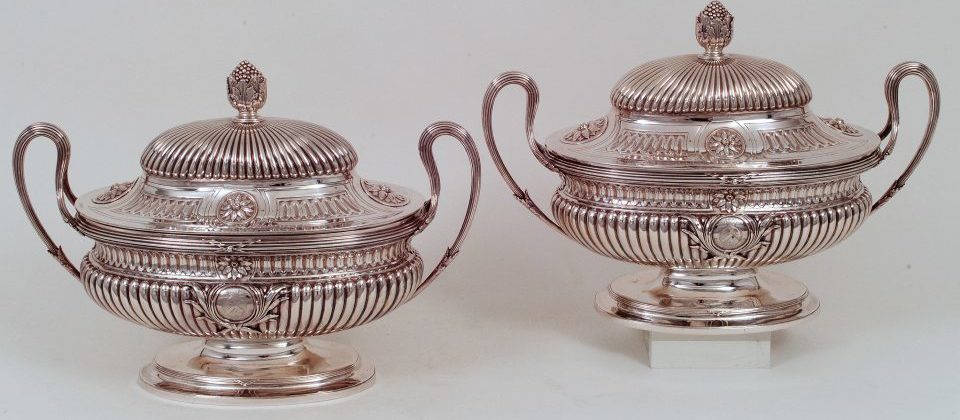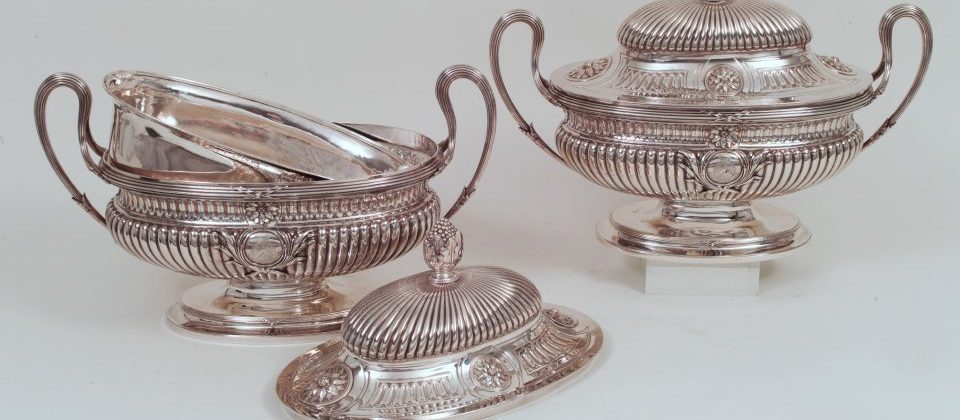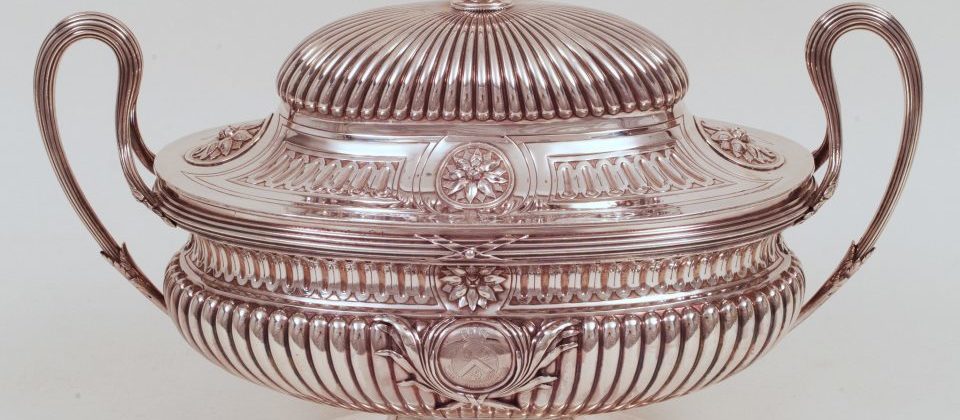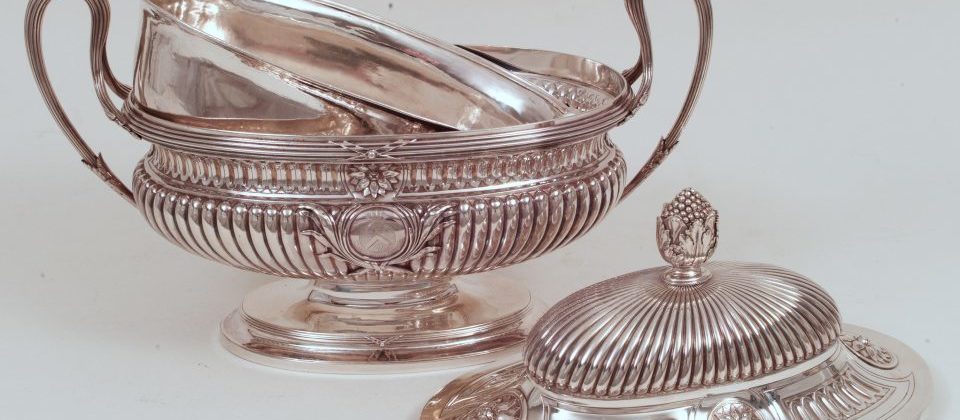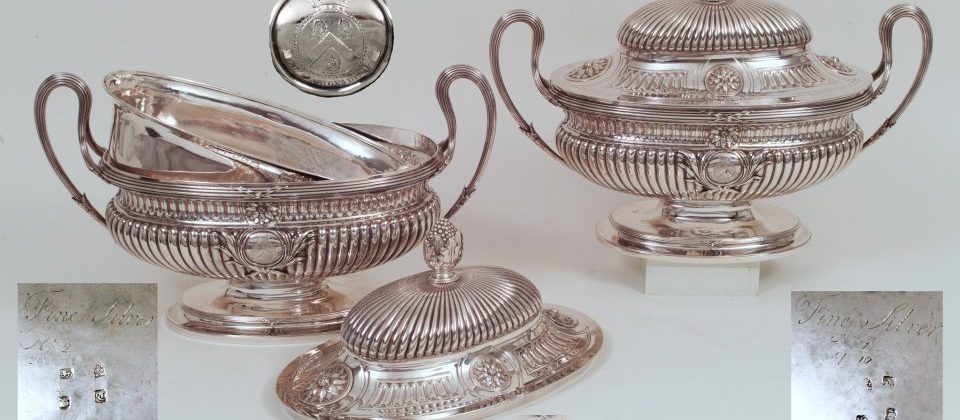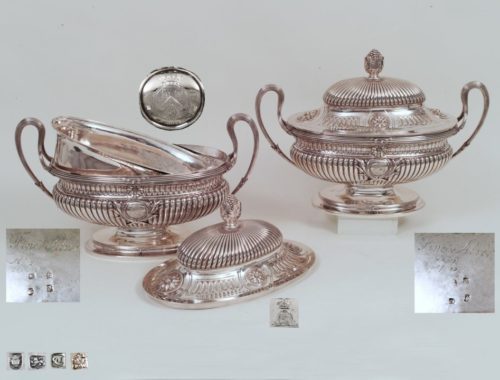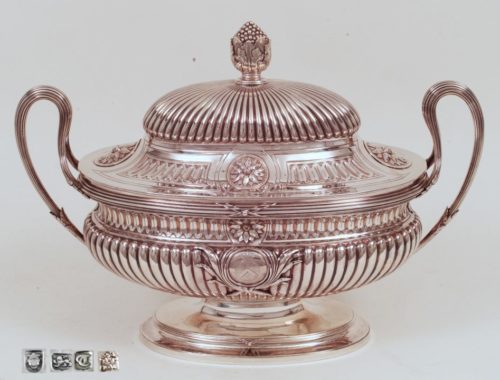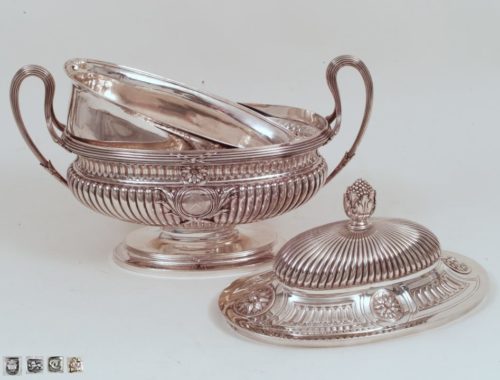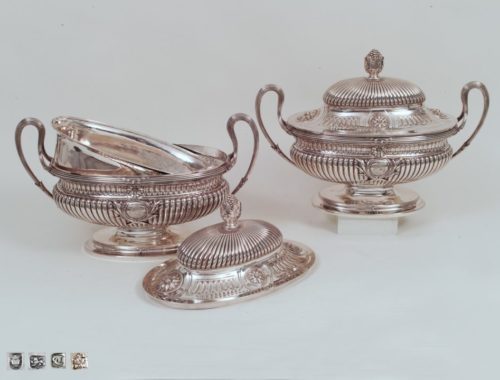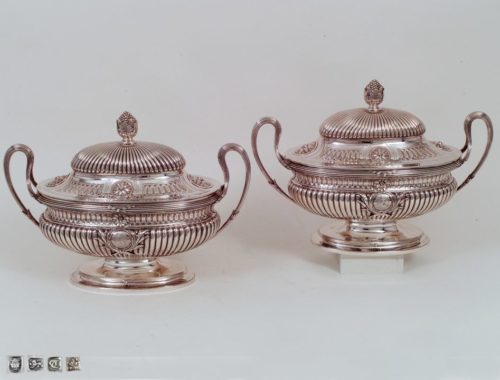Detailed Information
A Fine Pair of George III Silver Tureens Made by or in the Art of Sir William Chambers
The present pair of George III covered tureens with liners are very exceptional pieces of English silver. Not only their shape, but also the decorative elements, as well as the combination of neoclassicism with naturalism suggest that they might have been designed by the distinguished English architect Sir William Chambers.
The tureens have a bombé, vase-shaped body and this is raised on spreading, oval bases. The main decorative element of the pieces are the gadroons on the body and on the cover. This is being alternating with a frieze of lamb tongues interrupted by accentuated naturalistically made rosettes. The cast finial has the shape of an artichoke, while the side handles end at clasps of acanthus leaves. In the middle of every tureen, there are applied cartouches resting on crossed plumage and engraved with contemporary armorials. These belong to Sir George O’Brien (Wyndham), 3rd Earl of Egremont (1751-1837).
The Tureens most probably designed by Sir William Chambers
Upon comparison with identified pieces designed by Sir William Chambers (1723-1796) and continuing research, one can assume that the tureens have been designed by the architect on the request and order of the 3rd Earl of Egremont.
Many pieces in public and private collections show the same or with small differences, decorative elements as those on the present tureens, which are significant and typical for Chambers. According to the latest research, William Chambers was most active as a designer of silver between c. 1767 and 1772. After this period, he concentrated more on major public building projects. Chambers realised the designs for objects made of silver after a specific request of a patron and the execution of them was taken up and modified by London silversmiths. Wakelin and Parker are the makers of many of the existing pieces of whose design has been attributed to Chambers. These two have also had pieces realised under their auspices.
On the matter of the designer, looking closer into the details, an exactly same finial in the shape of an artichoke is to be seen on a dish and cover made by Parker and Wakelin in 1769 for the Duke of Marlborough, so called also the Blenheim dish cover (s. Young 1987, p. 400, fig. 6). This was designed by William Chambers after a large order made by George Spencer, fourth Duke of Marlborough (s. also Sir William Chambers: Architect to George III, p. 152, fig. 222).
Besides many decorative elements of the tureen made for the Duke of Marlborough coincide with those on the present pair of tureens. These include: the overall bombé shape of the tureen (a rather French influence), the thick gadroons on the cover, the oval standing foot of the vessel and the decorative frieze of it. Especially this last kind of frieze can be seen in some designs of John Yenn (1750-1821) as well. Yenn worked as a young apprentice and draughtsman for Chambers and was deeply influenced by him. As examples, can be mentioned two of Yenn’s designs from the second half of the eighteenth century for soup tureens after William Chambers held in the V & A Museum: one can see them online here and here. Moreover, this kind of banded reed ornaments frieze is to be seen in several tureens designed by Chambers (s. for instance the pair of tureens for the 10th Earl of Pembroke made by Chambers in 1771-2 in Young, 1996, p. 150, fig. 214).
Another decorative element which seems to be distinctive for Chambers is the finial, which is very often naturalistic, and the side-handles also naturalistically formed. Considering the handles, there is a design made by Chambers and Yenn in the Victoria & Albert Museum, which shows a very similar handle to the one on the present tureens. While another, similar one, is to be seen in the drawing of an ewer, held in the Sir John Soane’s Museum Collection.
All in all, it is most possible that the architect, who always had interest for interiors, objects and useful devices made of silver, is the designer of the present pair of tureens. An argument in favour of this hypothesis is also the fact that Chambers was designing objects for specific patrons. In the case of the tureens, the ordering customer, an important personality of his time, had most probably placed the order directly to an architect-designer and not to the silversmiths.
On the other side, the makers Parker and Wakelin were often executing the designs of Chambers and were thus familiar with his visual vocabulary. It might thus be that, if Chambers was not the designer himself, the makers used older drawings of him to execute their order for the present pair of tureens, creating a piece ‘in the art of Chambers’. Unfortunately, until now, no specific drawing has been identified for the present tureens. One can thus rely on the one or the other hypothesis.
Sir George O’Brien (Wyndham), 3rd Earl of Egremont (1751-1837)
Wyndram, 3rd Earl of Egremont (1751-1837) of Petworth House in Sussex and Orchard Wyndham in Somerset was a British peer, significant landowner and important art collector and patron. He had added O’Brien to his name, after having inherited estates in Ireland from his uncle. In 1763, at the age of twelve he succeeded his father. In 1767, he matriculated at Christ Church Oxford. During the 1770s, he undertook two Grand Tours in Italy, a popular activity for young men of the upper class in the UK and Europe. Although he decided not to embark on an active political career, on occasions, he did participate in politics being a member of the Whig party. However, his political role was limited.
Undoubtedly, Egremont’s greatest legacy was in the field of artistic patronage: William Turner (who had a studio in the Petworth House), John Constable, John Flaxman, and Benjamin Robert Haydon – were amongst those who benefited from his encouragement. All testified to the importance of the peaceful atmosphere of Petworth House – the Earl’s seat in Sussex – for their work. His philanthropy is evidenced by his funding of public works in Sussex and his vast charitable expenditure. It is estimated that over a period of sixty years, he donated some 1.200.000 pounds to various charitable causes.
The Earl collected French furniture and found decorative art and objects quite important – judging from drawings of Petworth House that have been saved in the British Museum and elsewhere (s. for instance these two: here and here).
Egremont called off a planned marriage to Lady Maria Walpole, granddaughter of the Premier Minister Sir Robert Walpole. Upon the announcement of the rupture, Sir Walpole saw fit to describe the Earl as ‘a most worthless young fellow’. By his future wife, Elizabeth Ilive he had six illegitimate children, and only one after their marriage, which died in infancy. The Earl was known to maintain around 15 mistresses and to have around 40 illegitimate children. On his death at the age of 86, Egremont was succeeded by his nephew, George Francis Wyndham, with whom, in 1845, the peerage became extinct. It is a measure of the life experiences of the 3rd Earl’s life that he was sponsored at his baptism in 1752 by George II, and died some months after the accession of Queen Victoria.
Sir William Chambers
William Chambers was born in Sweden and died in London. He travelled a lot, visiting among other countries China. He studied architecture at the École des Arts in Paris, from 1749 and in Italy from 1750 to 1755. Many of his drawings from this period are contained in his ‘Franco-Italian” album, held in the Victoria & Albert Museum. Chambers moved to London in 1755 and published in 1759 his Treatise on Civil Architecture, a quite influential work. Chambers demonstrated the breadth of his style in some important public buildings in London (such as Gower (later Carrington) House and Melbourne House). He was also influential in garden architecture. He became head of government building in 1782, and in this capacity built Somerset House, London. Even the Prussian Kind Frederick the Great (1712-1786), due to his interest for the English architecture, considered to appoint him as his court architect as Georg Wenzeslaus von Knobelsdorff (1699-1753) was ill.
Makers
The silversmiths Sebastian and Edward Wakelin were commissioning agents and retailers. John Parker, son of Thomas Parker, had learnt by George Wickes. John Parker and Edward Wakelin had a workshop together during the period 1758-1777.
Literature
Young, Hilary, ‘Sir William Chambers and the Duke of Marlborough’s Silver’ in Apollo 12.5 (June 1987), pp. 396–400.
Young, Hilary, ‘Silver, Ormolu and Ceramics’ in Harris, J. and Snodin, M. (eds.), Sir William Chambers: Architect to George III, Yale University in assoc. with the Courtauld Institute of Art, London: New Haven and London, 1996.
National Trust Images: https://artuk.org/discover/artworks (last visit: 19th July 2017).
Sidney Lee (ed.), Dictionary of National Biography, vol. 63 (Wordsworth-Zuylestein).
MacMillan & Co, Smith, Elder & Co., New York City-London 1900, p. 244.
https://en.wikipedia.org/wiki/George_Wyndham,_3rd_Earl_of_Egremont#cite_ref-5.


